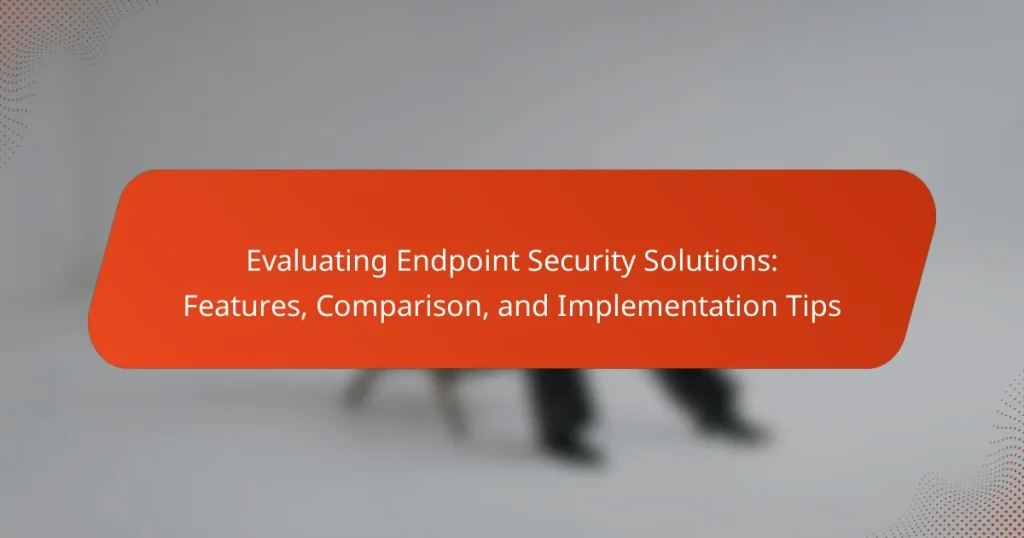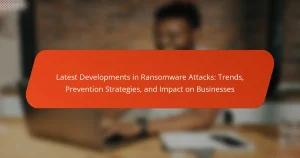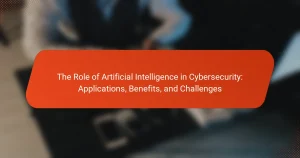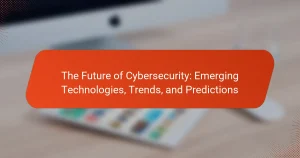Endpoint security solutions are cybersecurity measures designed to safeguard endpoint devices, including computers and mobile devices, from unauthorized access and cyber attacks. This article evaluates key features of these solutions, such as malware protection, firewall capabilities, and intrusion detection systems, which are essential for enhancing an organization’s security posture. It emphasizes the importance of real-time monitoring, threat detection, and centralized management for effective endpoint security. Additionally, the article provides guidance on comparing different solutions based on effectiveness, cost, and user feedback, and outlines best practices for implementation to minimize risks associated with data breaches and malware infections.
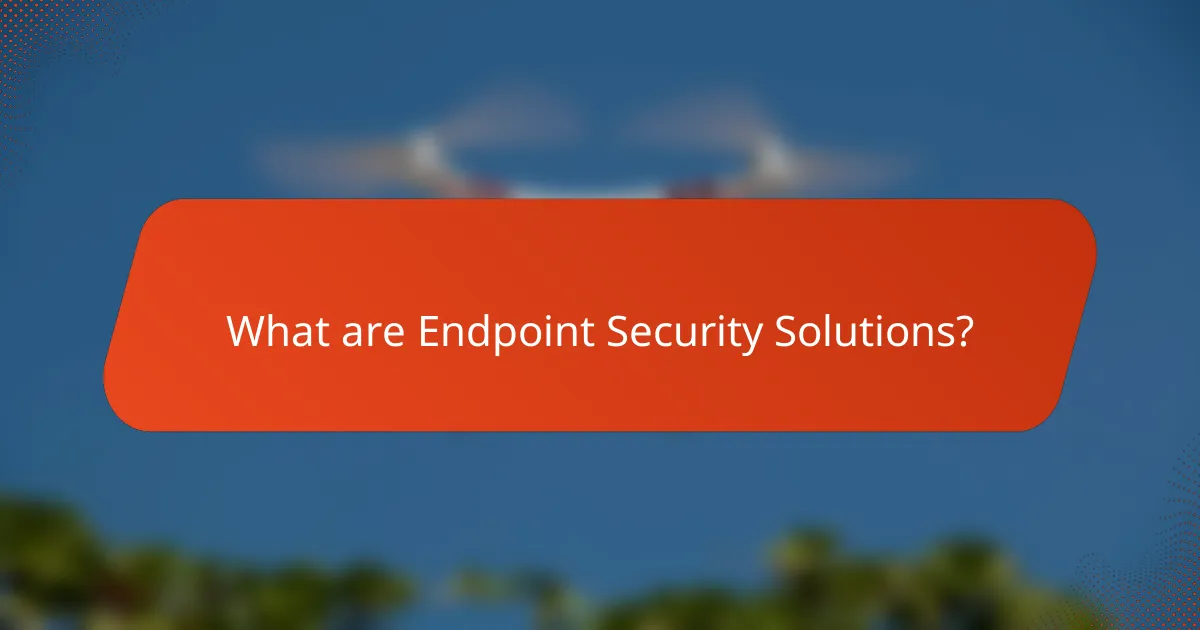
What are Endpoint Security Solutions?
Endpoint security solutions are cybersecurity measures designed to protect endpoints, such as computers and mobile devices. These solutions aim to prevent unauthorized access and attacks on these devices. They typically include features like antivirus protection, firewalls, and intrusion detection systems. Endpoint security solutions also provide real-time monitoring and threat detection. According to a report by Gartner, endpoint security is crucial as 70% of breaches originate from endpoint devices. Effective endpoint security can significantly reduce the risk of data breaches and malware infections.
How do Endpoint Security Solutions protect devices?
Endpoint Security Solutions protect devices by implementing a combination of technologies to detect and respond to threats. They monitor device activity in real-time to identify suspicious behavior. These solutions deploy antivirus and anti-malware tools to eliminate known threats. They also use firewalls to block unauthorized access to the devices. Additionally, they provide data encryption to secure sensitive information. Regular software updates and patches are applied to address vulnerabilities. Endpoint Security Solutions often include threat intelligence to stay ahead of emerging threats. According to a report by Cybersecurity Ventures, endpoint security is crucial as 70% of cyberattacks target endpoints.
What types of threats do Endpoint Security Solutions defend against?
Endpoint Security Solutions defend against various types of threats. They protect devices from malware, including viruses, worms, and trojans. These solutions also guard against ransomware attacks that encrypt data for extortion. Phishing attacks, which aim to steal sensitive information, are another threat mitigated by these systems. Additionally, they defend against unauthorized access and data breaches. Endpoint Security Solutions monitor for suspicious activities and network intrusions. They also provide protection against zero-day vulnerabilities, which exploit unknown software flaws. According to a report by Cybersecurity Ventures, cybercrime damages are expected to reach $10.5 trillion annually by 2025, highlighting the importance of these solutions.
What are the key components of Endpoint Security Solutions?
The key components of Endpoint Security Solutions include antivirus software, firewalls, intrusion detection systems, and data encryption. Antivirus software detects and removes malware from endpoints, ensuring device safety. Firewalls monitor incoming and outgoing network traffic to block unauthorized access. Intrusion detection systems identify and respond to potential threats in real-time. Data encryption protects sensitive information from unauthorized access during transmission and storage. Additionally, endpoint detection and response (EDR) tools provide advanced threat detection and remediation capabilities. These components work together to create a comprehensive security posture for endpoints, safeguarding against various cyber threats.
Why is evaluating Endpoint Security Solutions important?
Evaluating Endpoint Security Solutions is important to ensure robust protection against cyber threats. Effective endpoint security safeguards sensitive data and devices from malware and unauthorized access. According to a report by Cybersecurity Ventures, global cybercrime damages are projected to reach $10.5 trillion annually by 2025. This underscores the necessity of implementing effective security measures. Evaluating solutions helps organizations identify vulnerabilities and select the best fit for their specific needs. Regular assessments also ensure compliance with industry regulations and standards. Thus, thorough evaluation is essential for maintaining a secure digital environment.
How can a thorough evaluation prevent security breaches?
A thorough evaluation can prevent security breaches by identifying vulnerabilities in systems. It involves assessing current security measures and protocols. This process helps organizations understand their risk exposure. Regular evaluations can uncover outdated software or hardware. Identifying weak points allows for timely updates and improvements. According to a 2021 Verizon Data Breach Investigations Report, 85% of breaches involved human error or system flaws. Addressing these areas reduces potential attack vectors. Implementing findings from evaluations strengthens overall security posture. Thus, thorough evaluations are crucial in mitigating risks and preventing breaches.
What criteria should be considered during evaluation?
Key criteria for evaluating endpoint security solutions include effectiveness, usability, scalability, and support. Effectiveness refers to the solution’s ability to detect and mitigate threats. Usability assesses how easy the solution is for end-users and administrators. Scalability evaluates whether the solution can grow with an organization’s needs. Support considers the availability of technical assistance and resources. These criteria help ensure that the chosen solution meets the specific security requirements of an organization.
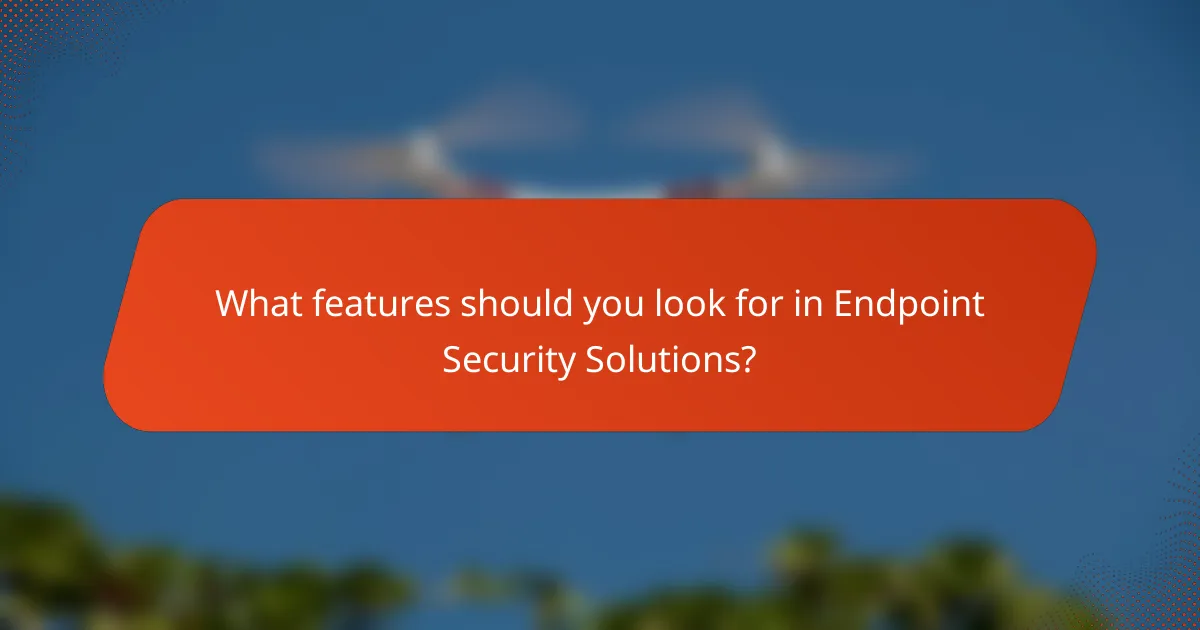
What features should you look for in Endpoint Security Solutions?
Look for features such as malware protection, firewall capabilities, and intrusion detection in Endpoint Security Solutions. Malware protection defends against viruses and other malicious software. Firewall capabilities monitor incoming and outgoing network traffic. Intrusion detection identifies unauthorized access attempts. Additionally, consider features like data encryption and device control. Data encryption protects sensitive information from unauthorized access. Device control manages and secures endpoints effectively. Finally, ensure the solution offers centralized management for streamlined oversight. Centralized management simplifies the administration of multiple devices. These features collectively enhance the security posture of an organization against cyber threats.
How do different features enhance security effectiveness?
Different features enhance security effectiveness by providing layered protection against threats. Features such as real-time monitoring detect and respond to security incidents as they occur. Advanced threat detection uses machine learning to identify unusual patterns and potential breaches. Automated patch management ensures that software vulnerabilities are addressed promptly, reducing risk. User authentication features, like multi-factor authentication, add an additional layer of verification. Encryption protects sensitive data both in transit and at rest, making it unreadable to unauthorized users. Centralized management allows for streamlined policy enforcement across all endpoints. Collectively, these features create a robust defense strategy that adapts to evolving threats.
What role does real-time monitoring play in Endpoint Security?
Real-time monitoring is essential in endpoint security as it enables the continuous observation of network activity and device behavior. This proactive approach allows for the immediate detection of suspicious activities or anomalies. By analyzing data in real-time, security teams can respond to threats before they escalate. According to a report by the Ponemon Institute, organizations with real-time monitoring capabilities can reduce the average time to detect a breach by 40%. This rapid detection is crucial in minimizing potential damage and data loss. Furthermore, real-time monitoring enhances compliance with security regulations by providing continuous oversight. Overall, it serves as a critical defense mechanism in safeguarding endpoints against evolving cyber threats.
How important is threat detection and response capability?
Threat detection and response capability is crucial for maintaining cybersecurity. It allows organizations to identify and mitigate threats before they escalate. Effective detection reduces the risk of data breaches and financial loss. According to a report by IBM, organizations with robust threat detection systems can reduce the average cost of a data breach by $1.2 million. Furthermore, timely response capabilities can prevent extensive damage to reputation and operations. In an era of increasing cyber threats, having this capability is not optional; it is essential for organizational resilience.
What are the benefits of advanced features in Endpoint Security Solutions?
Advanced features in Endpoint Security Solutions enhance protection against sophisticated cyber threats. They provide real-time threat detection and response capabilities. This allows organizations to mitigate risks promptly. Advanced features often include machine learning algorithms. These algorithms analyze patterns to identify anomalies. They can also automate incident response processes. Automation reduces the time to remediate threats. Additionally, advanced features support centralized management. This simplifies oversight of multiple endpoints. Enhanced reporting and analytics provide insights into security posture. Such insights help in informed decision-making.
How do machine learning and AI improve security measures?
Machine learning and AI enhance security measures by analyzing vast amounts of data to identify threats. These technologies detect anomalies in network traffic and user behavior. They can predict potential security breaches before they occur. Machine learning algorithms continuously learn from new data, improving their threat detection capabilities. AI can automate responses to security incidents, reducing response times. This results in quicker mitigation of risks. Research shows that organizations using AI-driven security solutions experience fewer breaches. For instance, a study by IBM found that AI can reduce the average time to identify a breach by 27%.
What advantages does centralized management provide?
Centralized management provides streamlined control over resources and policies across an organization. It enables uniform enforcement of security protocols, reducing the risk of vulnerabilities. Centralized systems facilitate easier monitoring and reporting of endpoint activities. This leads to quicker incident response times, as issues can be addressed from a single point. Additionally, centralized management simplifies software updates and patch management, ensuring all endpoints remain secure. Research shows that organizations using centralized management experience up to 30% faster response times to security incidents. This efficiency ultimately enhances overall security posture and compliance with regulations.
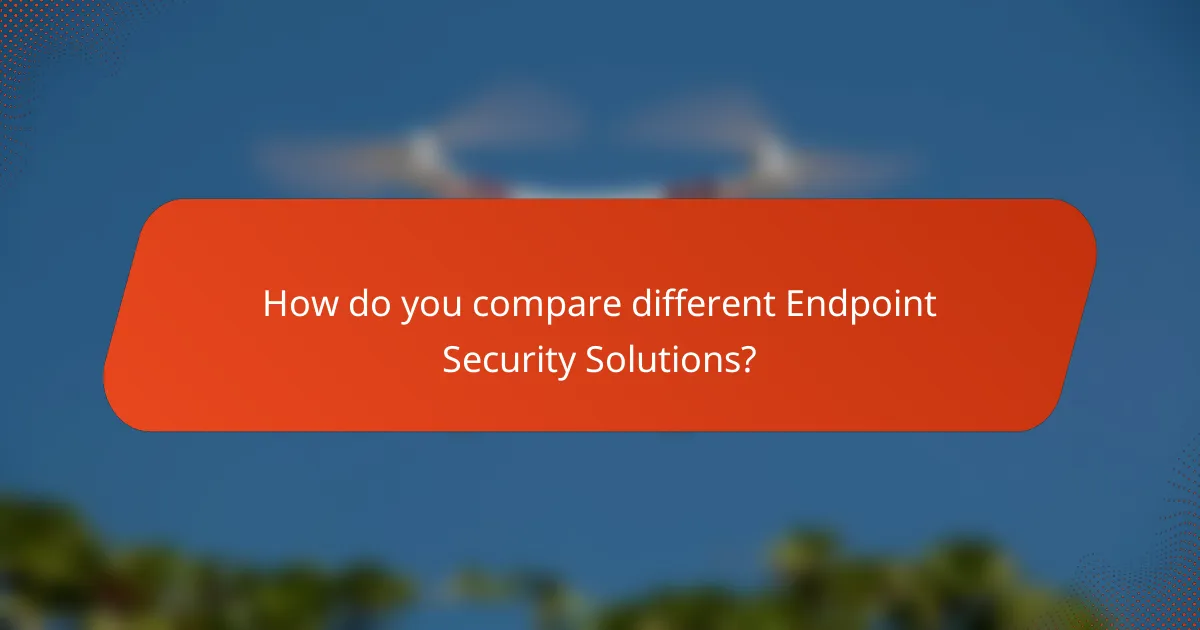
How do you compare different Endpoint Security Solutions?
To compare different Endpoint Security Solutions, evaluate their features, effectiveness, and cost. Focus on attributes such as malware detection rates, response times, and compatibility with existing systems. Assess whether they provide real-time protection and regular updates. Consider user-friendliness and the availability of customer support. Look for independent testing results, like those from AV-Test or SE Labs, which provide objective performance metrics. Analyze the scalability of the solution to accommodate future growth. Finally, review user feedback for insights on reliability and performance in real-world scenarios.
What metrics should be used for comparing Endpoint Security Solutions?
Key metrics for comparing Endpoint Security Solutions include detection rate, response time, and false positive rate. Detection rate measures how effectively the solution identifies threats. A high detection rate indicates better security performance. Response time refers to how quickly the solution can react to detected threats. Faster response times can mitigate potential damage. False positive rate measures the frequency of incorrect threat alerts. A lower false positive rate enhances operational efficiency. Additional metrics include system performance impact and ease of management. These factors collectively determine the overall effectiveness of the endpoint security solution.
How do pricing models affect the choice of Endpoint Security Solutions?
Pricing models significantly influence the selection of Endpoint Security Solutions. Different pricing structures, such as subscription-based, one-time purchase, or tiered pricing, cater to varying budgets and organizational needs. Subscription models provide flexibility and lower upfront costs, making them attractive for small to medium-sized businesses. One-time purchase models may appeal to larger enterprises with the capital for upfront investment. Tiered pricing allows organizations to choose features based on their specific requirements and budget constraints. According to a 2021 report by Gartner, 70% of companies prefer subscription models due to their scalability and predictable expenses. This preference shapes market offerings and drives vendors to adapt their solutions accordingly.
What is the importance of user reviews and case studies in comparison?
User reviews and case studies are crucial for evaluating endpoint security solutions. User reviews provide firsthand experiences and insights into the effectiveness and usability of a solution. They often highlight specific strengths and weaknesses that may not be apparent in marketing materials. Case studies offer detailed examples of how organizations have implemented solutions and the outcomes achieved. They provide context and real-world applications that help potential users understand practical implications. Together, user reviews and case studies build trust and credibility. Research indicates that 79% of consumers trust online reviews as much as personal recommendations. This statistic underscores the importance of user-generated content in decision-making processes.
What are the common pitfalls to avoid when comparing Endpoint Security Solutions?
Common pitfalls to avoid when comparing Endpoint Security Solutions include overlooking specific business needs. Many organizations fail to assess their unique security requirements before evaluation. This can lead to selecting a solution that does not address critical vulnerabilities. Another pitfall is focusing solely on price rather than value. The cheapest option may lack essential features or support. Additionally, ignoring vendor reputation and support can result in poor implementation experiences. Organizations should consider the vendor’s history and customer feedback. Lastly, neglecting to evaluate integration capabilities with existing systems can hinder overall security effectiveness. Solutions that do not integrate well can create gaps in security coverage.
How can bias in reviews skew the evaluation process?
Bias in reviews can significantly skew the evaluation process. It can lead to distorted perceptions of product effectiveness. For example, overly positive or negative reviews may not reflect actual performance. This misrepresentation can influence potential buyers’ decisions. A study by BrightLocal found that 82% of consumers read online reviews. Additionally, 79% trust online reviews as much as personal recommendations. If reviews are biased, they can mislead consumers about the quality of endpoint security solutions. Consequently, organizations may select suboptimal products based on skewed information. This ultimately affects their security posture and risk management.
What aspects are often overlooked during comparisons?
Aspects often overlooked during comparisons of endpoint security solutions include integration capabilities, user experience, and ongoing support. Integration capabilities refer to how well the solution works with existing systems. User experience impacts the efficiency of the solution in real-world scenarios. Ongoing support is crucial for addressing issues post-implementation. Additionally, total cost of ownership is frequently underestimated. This includes not just initial costs but also maintenance, updates, and potential scalability expenses. Understanding these factors is essential for making informed decisions.
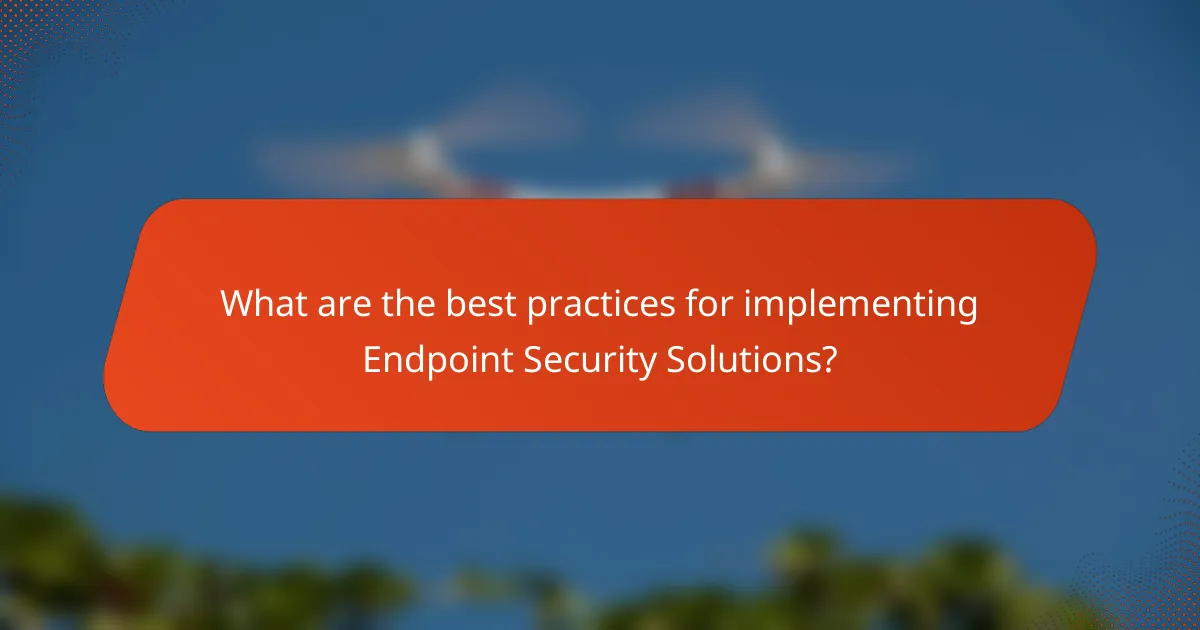
What are the best practices for implementing Endpoint Security Solutions?
The best practices for implementing Endpoint Security Solutions include assessing the organization’s specific needs. Conduct a thorough risk assessment to identify potential vulnerabilities. Choose a solution that integrates seamlessly with existing systems. Ensure regular updates and patch management for all endpoints. Implement multi-factor authentication for enhanced security. Educate employees on security awareness and best practices. Monitor and analyze endpoint activity continuously for unusual behavior. Regularly review and update security policies to adapt to new threats. These practices help create a robust endpoint security framework that minimizes risks.
How can organizations ensure a smooth implementation process?
Organizations can ensure a smooth implementation process by establishing clear objectives and timelines. Clear communication among team members is vital. Regular training sessions can prepare employees for new systems. Involving stakeholders early helps address concerns proactively. Testing the system in a controlled environment identifies potential issues. Monitoring progress throughout the implementation phase allows for timely adjustments. Gathering feedback from users aids in refining processes. Finally, documenting procedures provides a reference for future implementations.
What steps should be taken before deployment?
Conduct a thorough assessment of the current security environment before deployment. Identify existing vulnerabilities and potential threats to the system. Ensure all endpoint devices are inventoried and categorized. Evaluate the compatibility of the selected security solution with existing infrastructure. Train staff on new security protocols and procedures. Test the deployment in a controlled environment to identify issues. Develop a rollback plan in case of deployment failure. Document all configurations and policies for future reference.
How can user training enhance the effectiveness of Endpoint Security Solutions?
User training enhances the effectiveness of Endpoint Security Solutions by increasing awareness of security threats. Trained users are more likely to recognize phishing attempts and suspicious activities. This proactive identification reduces the likelihood of successful cyberattacks. According to a study by the Ponemon Institute, organizations with comprehensive security awareness training can reduce the risk of data breaches by up to 70%. Additionally, well-informed users follow best practices, such as using strong passwords and updating software regularly. This adherence to security protocols strengthens the overall security posture of the organization. Ultimately, user training creates a security-conscious culture that complements technical defenses.
What ongoing maintenance is necessary after implementation?
Ongoing maintenance after implementation of endpoint security solutions includes regular updates, monitoring, and incident response. Regular updates ensure that the software is equipped with the latest security patches. Monitoring involves continuous assessment of security logs and alerts for any unusual activity. Incident response procedures must be tested to ensure readiness for potential breaches. Regular training for staff on security practices is also essential. Additionally, conducting periodic security audits can identify vulnerabilities. These maintenance activities are crucial to maintaining the effectiveness of the security solution.
How often should security policies be reviewed and updated?
Security policies should be reviewed and updated at least annually. Regular reviews ensure that policies remain relevant and effective against emerging threats. Additionally, security policies should be updated whenever significant changes occur in the organization. These changes may include new technologies, regulatory requirements, or incidents that reveal vulnerabilities. According to the National Institute of Standards and Technology (NIST), regular updates help maintain compliance and improve overall security posture.
What are the signs that an Endpoint Security Solution needs adjustments?
Signs that an Endpoint Security Solution needs adjustments include increased security incidents. A rise in malware infections or breaches indicates potential gaps. Slow system performance may suggest resource overload from security processes. Frequent false positives can lead to alert fatigue among security teams. User complaints about access issues may signal misconfigurations. Ineffective threat detection rates show the solution may not be keeping pace with emerging threats. Additionally, outdated software versions can expose vulnerabilities. Regular assessments and updates are essential for optimal security performance.
What tips can help optimize the use of Endpoint Security Solutions?
Regularly update the endpoint security software to protect against new threats. Keeping the software current ensures that it has the latest security patches and features. Implement strong access controls to limit user permissions. This reduces the risk of unauthorized access to sensitive data. Conduct regular security training for employees to raise awareness about potential threats. Educated users are less likely to fall for phishing attacks or other scams. Monitor and analyze security logs frequently to detect unusual activity. Early detection of anomalies can prevent potential breaches. Use multi-factor authentication for an added layer of security. This makes it harder for attackers to gain access even if credentials are compromised. Regularly assess and test the effectiveness of the endpoint security measures in place. This can help identify gaps and improve overall security posture.
Endpoint security solutions are vital cybersecurity measures designed to protect devices such as computers and mobile devices from unauthorized access and attacks. This article evaluates the key features, components, and criteria for selecting effective endpoint security solutions, emphasizing their importance in mitigating threats like malware and data breaches. It also discusses best practices for implementation, ongoing maintenance, and the significance of user training in enhancing security effectiveness. Additionally, it highlights the importance of thorough evaluations and comparisons to ensure organizations choose the right solutions tailored to their specific security needs.
